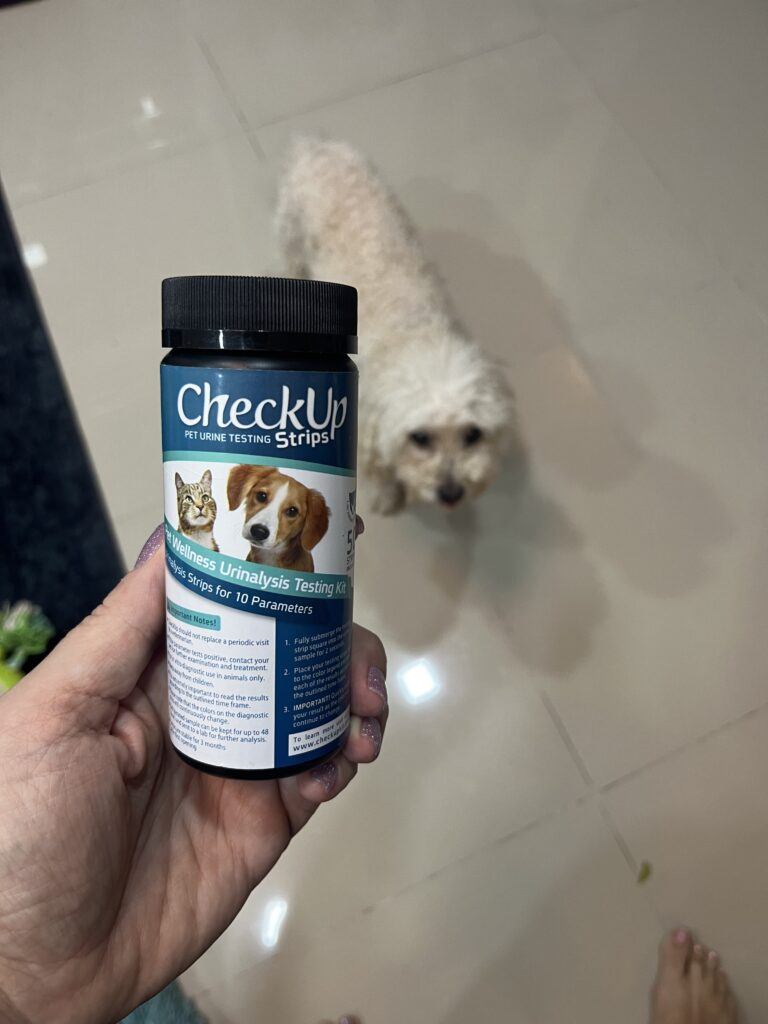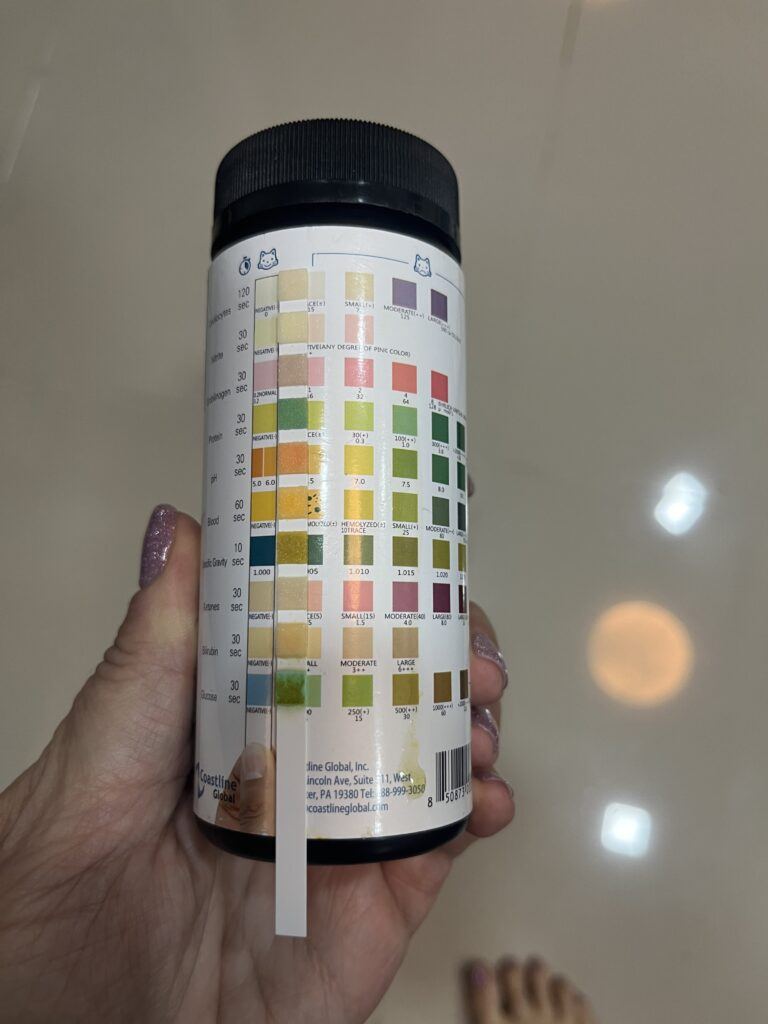Diabetes in dogs does more than raise blood sugar—it messes with their whole system, including the urinary tract. Elevated glucose levels mean glucose spills over into the urine. Sweet urine creates a favorable environment for growing bacteria, which leads to urinary tract infections (UTIs).

Symptoms of diabetes, such as frequent urination (polyuria) and excessive thirst (polydipsia), often overlap with UTI symptoms. If your diabetic dog is making frequent trips outside or drinking lots of water it can be easy to miss a lurking UTI. Watch for signs such as straining when peeing, blood in the urine, or just a funky smell from the pee—these are the tip-offs for UTIs.

While we visited in the USA this past summer, Brady stayed with his dog sitter. She sent us daily videos, photos, and updates on how Brady was doing.
One day she noticed blood in Brady’s urine. She immediately sent us a message and we asked her to take him to our vet. The vet prescribed a 5-day course of antibiotics that cleared things up quickly. When we got home we did some research and found that urinary tract infections are common in diabetic dogs. This was Brady’s first.
The concerns related to UTIs are not just the inconvenience of frequent bathroom breaks and extra water bowl refills. A UTI can upset your dog’s diabetes management. Infections spike blood sugar, making it trickier to keep things under control and creating an environment favorable for more infections, perpetuating the problem. Untreated, potential complications include ketoacidosis, which is seriously dangerous if not caught early. Your dog’s urine is another window into their overall health and one worth paying attention to.
Preventing UTIs in Diabetic Dogs
Knowing about the UTI risk is half the battle. The other half is avoiding recurring infections and managing them when they occur. Constant blood sugar spikes from untreated infections strain your dog’s health.
The key to avoiding severe complications is catching UTIs early. Regular vet visits are always important. Urinalisys home test strips are also helpful. These simple tests can spot an infection before it turns into something serious like a kidney infection (pyelonephritis). Untreated UTIs can escalate quickly, and in diabetic dogs, the stakes are even higher.
Check Up Pet Urine Testing Strips

We use Check Up Pet Urine Testing Strips.
They test 10 different parameters.
- Leukocytes: White blood cells that are part of the immune system’s response to infection. Their presence can signal that the body is fighting off a bacterial infection.
- Nitrites: Urine is converted into nitrite by certain types of bacteria. A positive nitrite test in a pet’s urine often indicates a bacterial UTI.
- Urobilinogen: A breakdown product of bilirubin, processed in the liver. Changes in urobilinogen levels can signal liver dysfunction or other systemic issues. Liver disease often requires different treatments from urinary tract issues, so it is important to know which one you are dealing with.
- Proteins: When the kidneys are inflamed or their filters are damaged, proteins leak into the urine. Excess protein in the urine suggests damage to the kidneys or inflammation in the urinary tract.
- pH: This measures the acidity or alkalinity of the urine. High pH (alkaline) may indicate a bacterial infection. Low pH (acidic) can affect the formation of urinary stones.
- Blood: When blood is present in urine it is a sign of irritation or inflammation in the bladder or kidneys. The causes of the blood can range from minor infections, trauma, and inflammation, to more severe conditions like bladder stones or cancer tumors within the urinary tract.
- Specific Gravity: Urine specific gravity measures the concentration of the urine. A low specific gravity indicates diluted urine, and a high specific gravity indicates concentrated urine. Abnormal urine concentration can signal kidney issues, dehydration, or endocrine disorders like diabetes. Monitoring this helps determine how well the kidneys are functioning.
- Ketones: Having ketones in the urine may indicate that the body is using fat for energy instead of carbohydrates, often due to diabetes, starvation, or prolonged vomiting. In diabetic pets, the presence of ketones can indicate diabetic ketoacidosis (DKA), a life-threatening condition that requires immediate medical intervention.
- Bilirubin: Processed by the liver, its presence in urine can signal significant liver problems or red blood cell breakdown. Early detection can lead to quicker treatment for liver disease.
- Glucose in the urine is the classic sign of diabetes mellitus, where the blood sugar levels are too high and spill over into the urine. (This was our first indication of Brady’s condition. He was drinking so much that he would leak urine in his sleep. When we cleaned it up and gave him a bath we noticed that it was sticky.) In non-diabetic pets, it may indicate stress or other underlying health issues.

Brady has slightly elevated protein and a high specific gravity on this test. The protein makes us think that maybe he didn’t completely get over his UTI this past August. We want to check in with the vet anyway, so we will take him soon.
Routine urine cultures might seem like too much to ask, but they’re easy to do and very helpful for dogs prone to recurring UTIs. Even if your dog looks healthy, a quick routine check can uncover hidden issues before they become problems. This worthwhile extra step allows you to make timely interventions and keep chronic infections in check.
Final Thoughts
To keep your dog’s urinary tract in good shape, make sure they have plenty of fresh water to flush out their system and encourage regular bathroom breaks to keep their urinary tract clear. Also, sticking to prescribed dietary guidelines will stabilize your dog’s overall health, making them less prone to infections.
It all boils down to being proactive. Managing a diabetic dog’s health can feel overwhelming at first, but when you settle into a routine for feeding, exercising, and monitoring important indicators such as regular glucose curves and urine test strips, you and your dog will be happier and healthier.
Please share your experiences in the comments below. We can all learn from each other. Thank you.

